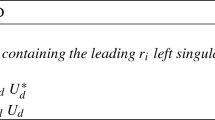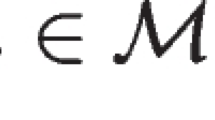Abstract
The tensor CUR decomposition in the Tucker format is a special case of Tucker decomposition with a low multilinear rank, where factor matrices are obtained by selecting some columns from the mode-n unfolding of the tensor. We perform a thorough investigation of what happens to the approximations in the presence of noise. We present two forms of the tensor CUR decomposition and deduce the errors of the approximation. We illustrate how the choice of columns from each mode-n unfolding reflects the quality of the tensor CUR approximation via some numerical examples.








Similar content being viewed by others
Notes
These two video datasets are at http://trace.eas.asu.edu/yuv/.
References
Bader, B.W., Kolda, T.G.: Algorithm 862: Matlab tensor classes for fast algorithm prototyping. ACM Trans. Math. Softw. 32(4), 635–653 (2006)
Bartholdi, J.J.: A good submatrix is hard to find. Oper. Res. Lett. 1(5), 190–193 (1982)
Boutsidis, C., Woodruff, D.P.: Optimal CUR matrix decompositions. SIAM J. Comput. 46(2), 543–589 (2017)
Breiding, P., Vannieuwenhoven, N.: The condition number of join decompositions. SIAM J. Matrix Anal. Appl. 39(1), 287–309 (2018)
Breiding, P., Vannieuwenhoven, N.: On the average condition number of tensor rank decompositions. IMA J. Numer. Anal. 40(3), 1908–1936 (2020)
Cai, H., Hamm, K., Huang, L., Needell, D.: Mode-wise tensor decompositions: multi-dimensional generalizations of CUR decompositions. J. Mach. Learn. Res. 22(185), 1–36 (2021)
Caiafa, C.F., Cichocki, A.: Generalizing the column-row matrix decomposition to multi-way arrays. Linear Algebra Appl. 433, 557–573 (2010)
Carroll, J.D., Chang, J.: Analysis of individual differences in multidimensional scaling via an \(n\)-way generalization of “Eckart–Young’’ decomposition. Psychometrika 35(3), 283–319 (1970)
Chaturantabut, S., Sorensen, D.C.: Nonlinear model reduction via discrete empirical interpolation. SIAM J. Sci. Comput. 32(5), 2737–2764 (2010)
Che, M., Wei, Y.: Randomized algorithms for the approximations of Tucker and the tensor train decompositions. Adv. Comput. Math. 45(1), 395–428 (2019)
Che, M., Wei, Y.: Theory and Computation of Complex Tensors and Its Applications. Springer, Singapore (2020)
Che, M., Wei, Y., Yan, H.: The computation for low multilinear rank approximations of tensors via power scheme and random projection. SIAM J. Matrix Anal. Appl. 41(2), 605–636 (2020)
Che, M., Wei, Y., Yan, H.: An efficient randomized algorithm for computing the approximate Tucker decomposition. J. Sci. Comput. 88, 1–29 (2021)
Cichocki, A., Lee, N., Oseledets, I.V., Phan, A.H., Zhao, Q., Mandic, D.P.: Tensor networks for dimensionality reduction and large-scale optimization: part 1 low-rank tensor decompositions. Found. Trends Mach. Learn. 9(4–5), 249–429 (2016)
Cichocki, A., Lee, N., Oseledets, I.V., Phan, A.H., Zhao, Q., Mandic, D.P.: Tensor networks for dimensionality reduction and large-scale optimization: part 2 applications and future perspectives. Found. Trends Mach. Learn. 9(6), 431–673 (2017)
Clarkson, K.L., Woodruff, D.P.: Low-rank approximation and regression in input sparsity time. J. ACM 63(6), 81–90 (2017)
De Lathauwer, L.: First-order perturbation analysis of the best rank-\(({R}_1,{R}_2,{R}_3)\) approximation in multilinear algebra. J. Chemom. 18(1), 2–11 (2004)
De Lathauwer, L., De Moor, B., Vandewalle, J.: A multilinear singular value decomposition. SIAM J. Matrix Anal. Appl. 21(4), 1253–1278 (2000)
Drineas, P., Ipsen, I.C.F.: Low-rank matrix approximations do not need a singular value gap. SIAM J. Matrix Anal. Appl. 40(1), 299–319 (2019)
Drineas, P., Kannan, R., Mahoney, M.W.: Fast Monte Carlo algorithms for matrices III: computing a compressed approximate matrix decomposition. SIAM J. Comput. 36(1), 184–206 (2006)
Drineas, P., Mahoney, M.W.: On the Nyström method for approximating a Gram matrix for improved kernel-based learning. J. Mach. Learn. Res. 6(12), 2153–2175 (2005)
Drineas, P., Mahoney, M.W.: A randomized algorithm for a tensor-based generalization of the singular value decomposition. Linear Algebra Appl. 420, 553–571 (2007)
Drineas, P., Mahoney, M.W., Muthukrishnan, S.: Relative-error CUR matrix decompositions. SIAM J. Matrix Anal. Appl. 30(2), 844–881 (2008)
Drineas, P., Mahoney, M.W., Muthukrishnan, S., Sarlos, T.: Faster least squares approximation. Numer. Math. 117(2), 219–249 (2011)
Eldén, L., Savas, B.: Perturbation theory and optimality conditions for the best multilinear rank approximation of a tensor. SIAM J. Matrix Anal. Appl. 32(4), 1422–1450 (2011)
Golub, G.H., Van Loan, C.F.: Matrix Computations, 4th edn. Johns Hopkins University Press, Baltimore (2013)
Goreinov, S.A., Tyrtyshnikov, E.E., Zamarashkin, N.L.: A theory of pseudoskeleton approximations. Linear Algebra Appl. 261, 1–21 (1997)
Grasedyck, L., Kressner, D., Tobler, C.: A literature survery of low-rank tensor approximation techniques. Ges. Angew. Math. Mech. 36(1), 53–78 (2013)
Grasedyck, L.: Hierarchical singular value decomposition of tensors. SIAM J. Matrix Anal. Appl. 31(4), 2029–2054 (2010)
Hamm, K., Huang, L.: Perspectives on CUR decompositions. Appl. Comput. Harmon. Anal. 48(3), 1088–1099 (2020)
Hamm, K., Huang, L.: Perturbations of CUR decompositions. SIAM J. Matrix Anal. Appl. 42(1), 351–375 (2021)
Higham, N.J.: Accuracy and Stability of Numerical Algorithms, 2nd edn. Society for Industrial and Applied Mathematics, Philadelphia (2002)
Hwang, T., Lin, W., Pierce, D.J.: Improved bound for rank revealing LU factorizations. Linear Algebra Appl. 261, 173–186 (1997)
Johnson, W.B., Lindenstrauss, J.: Extensions of Lipschitz mappings into a Hilbert space. In: Beals, R., Beck, A., Bellow, A., Hajian, A. (eds.) Conference in Modern Analysis and Probability (New Haven, CT, 1982), Contemporary Mathematics, vol. 26, pp. 189–206. American Mathematical Society, Providence, Rhode Islan, (1984)
Kilmer, M., Martin, C.: Factorization strategies for third-order tensors. Linear Algebra Appl. 435, 641–658 (2011)
Kolda, T.G., Bader, B.W.: Tensor decompositions and applications. SIAM Rev. 51(3), 455–500 (2009)
Kumar, S., Mohri, M., Talwalkar, A.: Sampling methods for the Nyström method. J. Mach. Learn. Res. 13(1), 981–1006 (2012)
Mahoney, M.W., Drineas, P.: CUR matrix decompositions for improved data analysis. Proc. Natl. Acad. Sci. USA 106(3), 697–702 (2009)
Mahoney, M.W., Maggioni, M., Drineas, P.: Tensor-CUR decompositions for tensor-based data. SIAM J. Matrix Anal. Appl. 30(3), 957–987 (2008)
Martin, D., Fowlkes, C., Tal, D., Malik, J.: A database of human segmented natural images and its application to evaluating segmentation algorithms and measuring ecological statistics. In: Proceedings Eighth IEEE International Conference on Computer Vision. ICCV 2001, Vancouver, British Columbia, Canada, vol. 2, pp. 416–423 (2001)
Mikhalev, A., Oseledets, I.V.: Rectangular maximum-volume submatrices and their applications. Linear Algebra Appl. 538, 187–211 (2018)
Miranian, L., Gu, M.: Strong rank revealing LU factorizations. Linear Algebra Appl. 367, 1–16 (2013)
Oseledets, I.V.: Tensor-train decomposition. SIAM J. Sci. Comput. 33(5), 2295–2317 (2011)
Osinsky, A.: Rectangular maximum volume and projective volume search algorithms. arXiv preprint arXiv:1809.02334 (2018)
Osinsky, A., Zamarashkin, N.L.: Pseudo-skeleton approximations with better accuracy estimates. Linear Algebra Appl. 537, 221–249 (2018)
Saibaba, A.K.: HOID: higher order interpolatory decomposition for tensors based on Tucker representation. SIAM J. Matrix Anal. Appl. 37(3), 1223–1249 (2016)
Sidiropoulos, N.D., De Lathauwer, L., Fu, X., Huang, K., Papalexakis, E.E., Faloutsos, C.: Tensor decomposition for signal processing and machine learning. IEEE Trans. Signal Process. 65(13), 3551–3582 (2017)
Song, Y., Qi, L.: Infinite and finite dimensional Hilbert tensors. Linear Algebra Appl. 451, 1–14 (2014)
Song, Z., Woodruff, D.P., Zhong, P.: Relative error tensor low rank approximation. In: SODA’19: Proceedings of the Thirtieth Annual ACM-SIAM Symposium on Discrete Algorithms, California, San Diego, January 6- 9, pp. 2772–2789 (2019)
Sorensen, D.C., Embree, M.: A DEIM induced CUR factorization. SIAM J. Sci. Comput. 38(3), A1454–A1482 (2016)
Stewart, G.W.: On the perturbation of pseudo-inverses, projections and linear least squares problems. SIAM Rev. 19(4), 634–662 (1977)
Stewart, G.W.: Four algorithms for the the [sic] efficient computation of truncated pivoted QR approximations to a sparse matrix. Numer. Math. 83(2), 313–323 (1999)
Stewart, G.W., Sun, J.G.: Matrix Perturbation Theory. Academic Press, Boston (1990)
Tarzanagh, D.A., Michailidis, G.: Fast randomized algorithms for t-product based tensor operations and decompositions with applications to imaging data. SIAM J. Imaging Sci. 11(4), 2629–2664 (2018)
Tropp, J.A.: Improved analysis of the subsampled randomized Hadamard transform. Adv. Adapt. Data Anal. 3(1–2), 115–126 (2011)
Tucker, L.R.: Some mathematical notes on three-mode factor analysis. Psychometrika 31(3), 279–311 (1966)
Vannieuwenhoven, N.: Condition numbers for the tensor rank decomposition. Linear Algebra Appl. 535, 35–86 (2017)
Wang, G., Wei, Y., Qiao, S.:,Generalized Inverses: Theory and Computations. 2nd edn. Springer, Singapore; Science Press, Beijing (2018)
Wang, S., Luo, L., Zhang, Z.: SPSD matrix approximation vis column selection: theories, algorithms, and extensions. J. Mach. Learn. Res. 17(1), 1697–1745 (2016)
Wang, S., Zhang, Z.: Improving CUR matrix decomposition and the Nyström approximation via adaptive sampling. J. Mach. Learn. Res. 14(1), 2729–2769 (2013)
Wang, S., Zhang, Z., Zhang, T.: Towards more efficient SPSD matrix approximation and CUR matrix decomposition. J. Mach. Learn. Res. 17(1), 7329–7377 (2016)
Woodruff, D.P.: Sketching as a tool for numerical linear algebra. Found. Trends Theor. Comput. Sci. 10(1–2), 1–157 (2014)
Xie, J., Xu, Z.: Subset selection for matrices with fixed blocks. Israel J. Math. 245(1), 1–26 (2021)
Acknowledgements
The authors would like to thank the handling editor Liqun Qi, the anonymous referees and Professor Eric Chu for their valuable suggestions which greatly help us to improve the manuscript. The first author is supported by the National Natural Science Foundation of China under grant 11901471. The second and third authors are supported by the National Natural Science Foundation of China under grant 11771099, the Innovation Program of Shanghai Municipal Education Commission and Shanghai Municipal Science and Technology Commission under grant 22WZ2501900.
Author information
Authors and Affiliations
Corresponding author
Additional information
Communicated by Liqun Qi.
Publisher's Note
Springer Nature remains neutral with regard to jurisdictional claims in published maps and institutional affiliations.
Rights and permissions
About this article
Cite this article
Che, M., Chen, J. & Wei, Y. Perturbations of the Tcur Decomposition for Tensor Valued Data in the Tucker Format. J Optim Theory Appl 194, 852–877 (2022). https://doi.org/10.1007/s10957-022-02051-w
Received:
Accepted:
Published:
Issue Date:
DOI: https://doi.org/10.1007/s10957-022-02051-w
Keywords
- Tensor CUR decomposition
- Low multilinear rank approximation
- Maximal volume sub-matrices
- Mode-n unfolding
- Tucker decomposition




